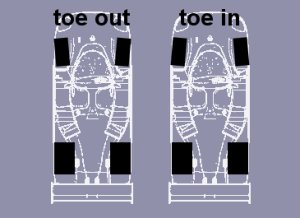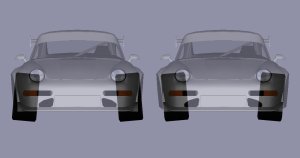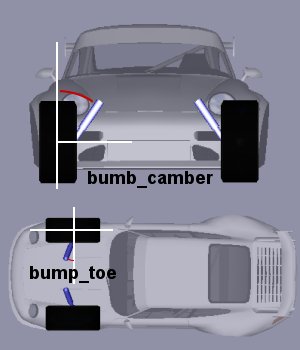|
There's a lot of parameters to define the car's suspensions, and quite some of
these you'll only be able to set it's min,max ranges in physics - fine tuning has
to be done on Garage screen in the game, as it's part of setting up the car for
each specific track.
On some of these parameters you'll not even be able to fine tune it's
values in Garage - these are set to defaults by track physics (ride, toe)
| TABLE |
PARAMETER |
DIMENSION |
| Table Front/Rear |
toe |
min,max angle |
| Table Front/Rear |
caster |
|
| Table Front/Rear |
ride |
min,max |
| Table Front/Rear |
anti_pitch |
|
| Table Front/Rear |
camber |
min,max angle |
| Table Front/Rear |
camber_peak |
angle |
| Table Front/Rear |
camber_grip |
|
| Table Front/Rear |
camber_stiff |
|
|
For toe, in physics you only set it's range. What toe
actually will be used, is set by track physics if it cannot be adjusted in Garage (most mods)
What is toe ?
toe is the angle that wheels are out of running parallel to each other. It has big impact
on directional stabilty, while too high toe settings will cause tires to scrub - and wear out
fast on inboard egdes.
Usually you might want only to allow for very little toe-in/-out on the rear wheel,
and only a little more on the front wheels to improve directional stabilty
|
 |
 |
caster is the way the wheels' center travels behind or in front of the
car's front or rear axis. Positive caster makes the wheels' center travel
a little behind the referring axis - and straightens the wheel on the car's
forward movement, enhancing straight-line stability. There's side-effects
on how sensitive the car will respond to steering. Too much caster will
decrease the car's turning ability.
Typically there will be no rear caster, but somewhat from 0.0 - 10.0 positive caster
on front wheels.
anti_pitch basically defines the resistance to the motion that increasing caster
allows. Thus the effects of anti_pitch depends on how much caster is set. If caster
is set to 0, there's hardly any effect |
|
camber is the angle of the wheel relative to y-axis. Negative camber will
make the wheels top lean towards the car, while positive camber will make it lean
away. With camber parameter you set the min,max range of what camber for
each wheel can be adjusted to in Garage screen.
camber_peak defines camber angle of maximal lateral grip;
camber_grip sets stiffness at camber_peak, while camber_stiff
sets the tires' stiffness at peak |
 |
 |
ride sets how far above the track the car's bottom will be.
In NHeat physics you can only set the min, max range for ride, what
value actually will be used is set by track physics, it manual adjustment isn't
supported by the mod.
Low ride positively affects speed, downforce and stabilty, but may cause
the car's body to scratch on the track's surface if set too low. Moreover,
by limiting ride range, you can kind of take care that suspension travel doesn't
make wheels exceed the car's wheel wells |
| TABLE |
PARAMETER |
DIMENSION |
| Table Front/Rear |
rate |
min,max |
| Table Front/Rear |
rubber_height |
|
| Table Front/Rear |
rubber_rate |
|
| Table Front/Rear |
rebound |
min,max |
| Table Front/Rear |
bump |
min,max |
| Table Front/Rear |
bump_camber |
angle |
| Table Front/Rear |
bump_toe |
angle |
Spring rate range for front wheels is half as much as will show up in
Garage, different to rear wheel spring rate. What specific spring rate values actually will be
used has to be set up in Garage
On NASCAR type cars there's additional rubbers that limit spring travel; rubber_height
sets these rubbers' height, rubber_rate defines the rubbers' stiffness. For non-NASCAR
cars, in most cases you'll want to set both values to 0.0.
 |
The shock absorbers' specs are defined by setting bump and rebound rates
(min,max each). What bump/rebound rates are actually used has to be set up in Garage
The shocks' geometry is set by bumb_camber and bumb_toe parameters. While
the shocks' vertical angle is set by bumb_camber, it's horizontal angle is set by
bumb_toe
Too much bump toe-in will cause the car to dart over bumps and understeer on corner
entries while too much toe-out will additionally cause the car to wander while braking.
The shocks' camber has impact on the bump travel - and thus how sensitive the car
will be to bumps. |
| TABLE |
PARAMETER |
DIMENSION |
| Table Front/Rear |
sway |
|
sway bars are sometimes known as stabilizers - which pretty well describes what they are
put in for : stabilizing the car, especially against roll. They stiffen the car's attitude on
steering. In Heat physics, you have to set the (anti-)sway-bars' stiffness range.
 |
[ Physics: Suspensions ] |
 |
|
|